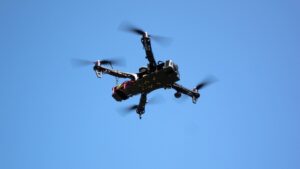New Jersey Drone Sightings Prompt FAA Action: What Investors Need to Know
In an unexpected move, the Federal Aviation Administration (FAA) has imposed temporary restrictions on drone flights over 22 key locations in New Jersey. This regulation comes in the wake of numerous reports from local residents about strange and brightly illuminated drones operating in the night sky.
The FAA’s Response to Rising Concerns
As stated by the FAA, these Temporary Flight Restrictions (TFRs) are a direct response to concerns raised by federal security partners. The newly designated no-fly zones apply to critical infrastructures throughout central and northern New Jersey, which includes populated areas such as Elizabeth, Camden, and Jersey City—the state’s second-largest city. These restrictions are set to remain in place until January 17, raising a myriad of questions among residents and investors alike about the future of drone technology and regulations.
Investigating the Mystery Drones
Local officials and law enforcement agencies have voiced frustration over the lack of transparency regarding the drone sightings. The FBI and the Department of Homeland Security (DHS) affirm that they have found "no evidence" linking these drones to any national security threats or criminal activities. In fact, the agencies suggested that many of the reported sightings may actually be misidentified manned aircraft. This raises an interesting point for investors: the need for better identification technology and tracking systems in the drone industry.
Impact on Drone Stocks
Amidst the speculation and concern, there has been a notable uptick in drone stocks this week. Particularly, shares of Red Cat Holdings, a Puerto Rico-based drone company, surged roughly 10% following the announcement of a partnership with Palantir, a leading data analytics firm. As the appetite for drone technology increases, partnerships like these could signal a shift in the airspace usage and regulatory frameworks.
A Look Ahead: Opportunities and Insights
While the immediate effects of the FAA’s regulations may appear limiting, they could paradoxically open doors for innovation within the drone industry. Here are some key takeaways and predictions for investors looking to navigate this evolving landscape:
-
Increased Regulatory Oversight: As drone sightings become more frequent and complex, it is likely that regulatory frameworks will become more stringent. Companies developing compliance technologies will find new opportunities as demand for these products increases.
-
Investing in Identification Technologies: The current drone sighting confusion highlights a growing market for advanced identification systems. Companies specializing in this space could see significant growth opportunities as governments and businesses alike rush to improve their tracking and monitoring capabilities.
-
Public Perception is Key: The current uncertainty has stirred public apprehension about drone technology. Companies that emphasize transparency and proactive community engagement will be more likely to win public trust and long-term adoption.
- Collaboration is Crucial: Partnerships like the one between Red Cat Holdings and Palantir could set a precedent for collaborative approaches in the drone industry. Investors should monitor such alliances closely, as these partnerships can lead to breakthroughs in technology and market penetration.
As we witness an intriguing confluence of regulatory scrutiny and technological advancement in the drone industry, the road ahead for investors remains dynamic. Staying informed and understanding the nuances of these developments will be crucial for anyone looking to capitalize on the growing drone market.
For more insights, analysis, and updates from the world of business and investment, stay tuned to Extreme Investor Network, where we delve deeper into market trends and opportunities that matter to our readers.

